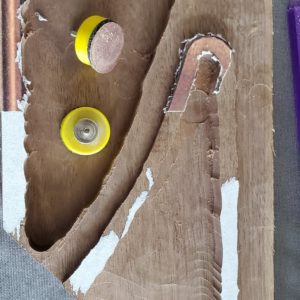Howdy all,
I have a project I want to sand and finish (pic of part attached). For scale, those yellow sanding disc holders are 1 inch in diameter.
I picked them up with the idea of using my rotary tool to move along the space where I can, and hand sand the areas it can’t reach (and do a final hand sanding before finishing with Danish oil.) The more I look into sanding the more “go with the grain” and “random orbit” come up.
So my question is should I use the rotary and move it along the grain then a once over hand sanding, or should I just hand sand it all the way? Planning 120/150->180->220->Danish oil.
What are some considerations for if I do decide to use the sanding discs?
Thanks!
















Replies
Do you just want the edges of the raised areas smoothed? Or do you need the flat background smooth as well?
You're going to need something besides those wee sanding discs, either way.
I'm planning on sanding the entire piece. I do have appropriate grit sand paper as well, but the for most of the piece I can't use a block or a standard power tool.
Advice?
Are the scalloped surfaces going to stay? If the intent is smooth raised curves get as much done towards fairing the walls as possible with chisels before you start sanding. The deep router chatter marks are going to be a bear. You might try working them into the surrounding surface with gouges and scrapers before sanding.
I think a rotating sander will leave swirls you'll be fighting with until the end. There are straight-line detail sanders that might help, but in the end it will be just you and your sore fingers.
I'm guessing you used the router free hand? If you use a pattern and a good pattern bit, you should be able to get a surface that needs almost no sanding, right off of the router.
Otherwise, I would use chisels and gouges to clean up most of this before attempting to sand.
Took me a moment to realize what I was looking at, my fault not yours ;-) A template or other guide will give you a near finished result for most or all of that depending on how involved you want the template to be.
Thanks everyone for weighing in.
I live in a small apartment with zero room for proper equipment (not to mention the noise and dust!) so I have to work outside at parks or anywhere with an outlet... (and proper eye, mouth, ear protection of course) everyone has to start somewhere.
I did freehand with a router which, due to the different levels in the piece led to a few wobbles as the support for the router lessened (each of which took some of my soul). I would ideally like a smooth finish, working out those pock marks. In terms of that jaggedness (scalloping), I can smooth that out with my router and rotary tool, there's still some work to be done to match curves and smooth everything out.
I suppose the rest will need to be meticulously sanded by hand. I'm OK with that since I'm in no hurry and I want it to look great. I had the thought that those little discs could still come in handy as a sort of sanding block.
This is my first real project, and considering that I have no proper work space and just a smattering of tools, I think it's coming along.
If you haven't already, replace the baseplate of the router with a much larger pc of 1/4" plexiglas to spread out to wider support surfaces. If you stiffen the plexi with wooden runners you can even support the router on feet attached to the plexi or outside runners fastened to the edges of your workpiece. With that done you may even be able to take a light pass on the recessed surfaces to clean them up.
hand rasps or floats might reduce the coarser areas.
“[Deleted]”
@ _MJ_ This is an excellent idea, thank you!
@ Stantheman I'll look into those, thanks!
What I see is a roughed out carving that you could complete by marking the contour with a fine black marker and carve out with chisels. Then sanding would take it a step further.
This forum post is now archived. Commenting has been disabled